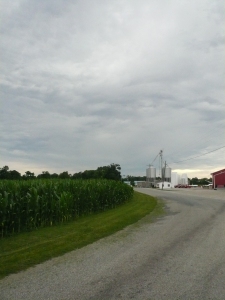To be in touch with our landscapes is to be conscious of our evolving experiences, to be aware of the ways in which we encounter our world.
The above statement comes from Greene’s preface to Landscapes of Learning (1978, page 2). As she sets up her book, the role of the landscape takes center stage to the process of learning and understanding the world. The landscape is the lived life of an individual, the experiences that create one’s world. As an artist, the concept of this landscape opens up a new way of conceptualizing what happens to each of us as we learn. Just like portraiture as a research method changed my own perspective on my role as an educator, a researcher, a student and an artist, the landscape has opened up a way for me to understand Polyani’s personal knowledge in a new light….an aesthetic one.
Looking at the more colloquial concept of landscape, fresh in my mind is that of Indiana cornfields. Having lived in Indiana for all of my adolescence and into adulthood, I am extremely partial to both the Northern Indiana landscape of cornfields, tree lines, and big, open sky, as well as the very green, hilly, and luscious vista of Southern Indiana. While to many people, these landscapes are simply a daily part of life. They are so ingrained as the landscape to their daily life that they don’t often appreciate the effects they have. But coming from an urban landscape as a child, I was always a little more attuned to it in Indiana.

Road back from the Triangle
I’m generalizing a little here, I know. But I think it is a safe assumption to make that sometimes we need to be away from home in order to truly appreciate it. It’s easy to walk the same streets, drive the same roads, and not be aware of everything around you. Looking back at my time in Indiana and how it feels when I return now, I am glad I have always been able to enjoy the fields alight with fireflies, the random huge tree in the middle of acres of soybean, and the way the state road seems to disappear over a hill.
So how did I miss the fifty year old “NO BALL PLAYING” sign on the corner of my block here in Chicago?
With the physical landscapes of our lived lives, we come into confrontation in different ways – by leaving for a while, from carrying previous perspectives, from artistic approaches, and so on. Greene is referring to a landscape that is interior, but she also says that we need to experience a self-confrontation. This self-confrontation is closely related to her concept of wide-awakeness that has guided my graduate study (among other aspects of my life) since I encountered it. She defines self-confrontation as a discovering of “new vistas of personal vitality” (page 32) arousing us from a kind of submergence.
This self-confrontation can create a transcendence that can “allow one to go beyond what one has been” (page 36), but it requires finding what Greene calls openings. I understand these openings as spaces within one’s landscape that will allow the light to change, the perspective to skew, the tone to shift, the story to emerge a little truer, a little deeper.
With a new frame to view the work of Greene, and the work of mine, I continue and hope to seek ways to develop opportunities for students to confront their landscape in meaningful ways, looking for spaces, and a stronger ability to walk their paths wide-awake.
I love this blog. How inspiring to see that you’re juggling all the many parts of your life and still keeping some sort of catalogue, artfully. Very nice.